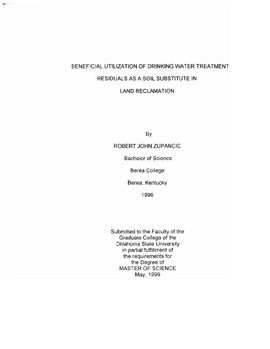| dc.description.abstract | Soil substitutes are in great demand for land reclamation due to large areas of abandoned mine lands and urban development in Oklahoma. Dewatered drinking water treatment residuals (WTR) have properties and characteristics similar to fine-textured soils and may be useful as a soil substitute. However, past studies have shown that vegetation grown on WTR amended soil exhibit P deficiencies. The objectives of this experiment were to determine if i) WTR can support vegetative growth, ii) P fertilizer additions can over come vegetative P deficiencies, and iii) soil tests used to make P fertilizer recommendations can be used to predict WTR utilization as a soil substitute and predict vegetative response to P fertilizer additions. In this study, three alum WTR ranging in P adsorption capacity, were evaluated and compared with a Grant silt loam soil. Bermudagrass (Cynodon dactylon) was grown with P fertilizer additions of 0,50, 100, and 200 mg P kg-\ with four replications per treatment. Tissue concentrations of P, K, Ca, Mg, Mn, AI, Cu, Fe, and Zn were determined for each vegetation harvest. Phosphorus adsorption isotherms, water soluble-P (H20-P), Mehlich-3 P (M3-P), and resin extractable P (UNIBEST-P) were measured for the untreated and P amended WTR and soil. Plant response to unamended and P amended materials were evaluated by the total accumulative plant yield and the tissue-P concentration at the last harvest. A bermudagrass sufficient tissue-P concentration was determined to be 2,500 mg P kg-1 based upon other research and the results of this experiment. Bermudagrass grown on Grant soil yields (15, 20, 27 g por^(-1) , respectively) responded to P addition on the first three P rates (0, 50, 100 mg P kg-I) and tissue-P concentrations (1360, 2230, 2550, 3880 mg P kg-1, respectively) responded across all treatments. However, bermudagrass grown in the WTR did not respond to P fertilizer additions. When P was not added, bermudagrass yields followed the trend of Mohawk> Grant soil> Wister> ABJ (27.0, 15.1, 7.0, 0.9 g por1, respectively). Bermudagrass tissue-P concentrations were Grant soil> Mohawk> Wister> ABJ (3000, 2360,1320,578 mg kg-1 , respectively). Overall, yields of the bermudagrass grown on the soil increased with P fertilizer additions, but did not show increased responses to P fertilization when grown on WTR. Phosphorus adsorption capacity followed the trend Grant soil < Wister < Mohawk < ABJ, but did not describe the growth potential where Grant soil, Mohawk> Wister> ABJ. The Grant soil, ABJ, and Wister exhibited a linear increase in M3-P with P addition; however, only the Grant soil responded with increased bermudagrass yields with P additions. Poor relationships between WTR M3-P and bermudagrass yield, tissue-P concentrations, and P-uptake were found. H20-P increased linearly for P additions on the Grant soil, while H20-P was deficient at all P additions. The UNIBEST method was able to extract increasing amounts of P with time from the Grant soil, ABJ, and Wister (I = 14.2, 12.1, 4.42 ~g resin-', respectively), but was not able to accurately predict the P requirements for adequate vegetative growth. Based on forage yield and tissue-P concentration data, the Mohawk and Wister WTR can be used as a soil substitute. ABJ is not suitable as a soil media due to growth inhibition and severe P deficiency of this material. Phosphorus adsorption isotherms, M3-P, and resin-P were not accurate predictors of vegetative growth on WTR with P addition. M3-P was a good predictor of which WTR materials would adequately support vegetative growth. H20-P was related to plant growth, but test results were variable and difficult to duplicate. Soil P tests were unable to accurately predict fertilizer P required to correct P deficiencies of the WTR. | |
